Career Advice
How To Email The Hiring Manager (And Get A Response!)

Have you applied to dozens of job openings on job boards, only to hear nothing back?
It’s a common problem many of our clients face!
The issue is this:
HR or Hiring Managers receive a massive number of job applications through these job boards.
Too many of these applicants are unqualified candidates who are just “trying their luck.” And often, due to the complexity of the role, HR isn’t able to accurately identify who the highest quality candidates are.
So in this sea of countless job applications and CV submissions, how can you get yours to stand out?
Here's our quick tip: bypass job portals, and email the Hiring Manager directly!
Use Job Portals for Research Instead
Don't apply for openings directly on job portals.
Why?
Everyone applies to these job portals. It's hard to stand out and get noticed!
Look at this screenshot from a local job portal, for example:
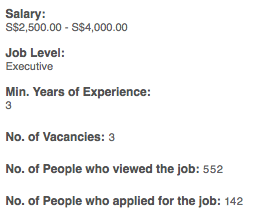
It’ll be IMPOSSIBLE to stand out from 142 other applicants.
So avoid applying directly on job boards, if you can!
Please don’t get us wrong – you should still set up accounts with job portals, log-in to them, and scout around. After all, you'll need to know which companies are hiring.
But once you identify those open positions and companies, you need to take a different approach. Capturing a Hiring Manager's attention through job portals is a tall task.
That's why you should learn...
How to Email Hiring Managers:
- Get a referral to the Hiring Manager
- Search for the Hiring Manager on LinkedIn (if you can’t get a referral)
- Find the Hiring Manager's email address (using the Skrapp plugin)
- Email the Hiring Manager to:
- Give smart suggestions on their business or
- Ask for a small favour
Getting in touch with Hiring Managers directly and cultivating a relationship with them is your best way to get your foot in the door.
Did you notice that you won't have to go through HR at any point in this process?
Nor do you send your CV and Cover Letter through right off the bat?
That's the trick.
You're bypassing all the gatekeepers to go straight to the final decision maker – the Hiring Manager.
And you're doing it in a small, subtle way that makes it incredibly difficult for the Hiring Manager to say no.
Step 1: Get a Referral
Once you've identified the job and company, find out if you have any old friends or former colleagues who work there. Get in touch with them, and ask them to help you get a referral to the Hiring Manager.
Time and time again, we've found that this is the best way to get in touch with a new company.
Hiring Managers value referrals from existing employees very highly. It shows that the applicant is resourceful and well connected.
If you can't get a referral, you’ll have to use a more long winded method to get in touch with the Hiring Manager.
Read on...
Step 2: Find the Hiring Manager on LinkedIn (if no referral available)
If you don't have any friends who can help, use LinkedIn to find the hiring team at the target company.
For example, if you’re interested in a social media marketing role at Singapore Airlines, go to LinkedIn and search for “social media Singapore Airlines”
LinkedIn will then show you a list of social media marketing executives who work at the company.
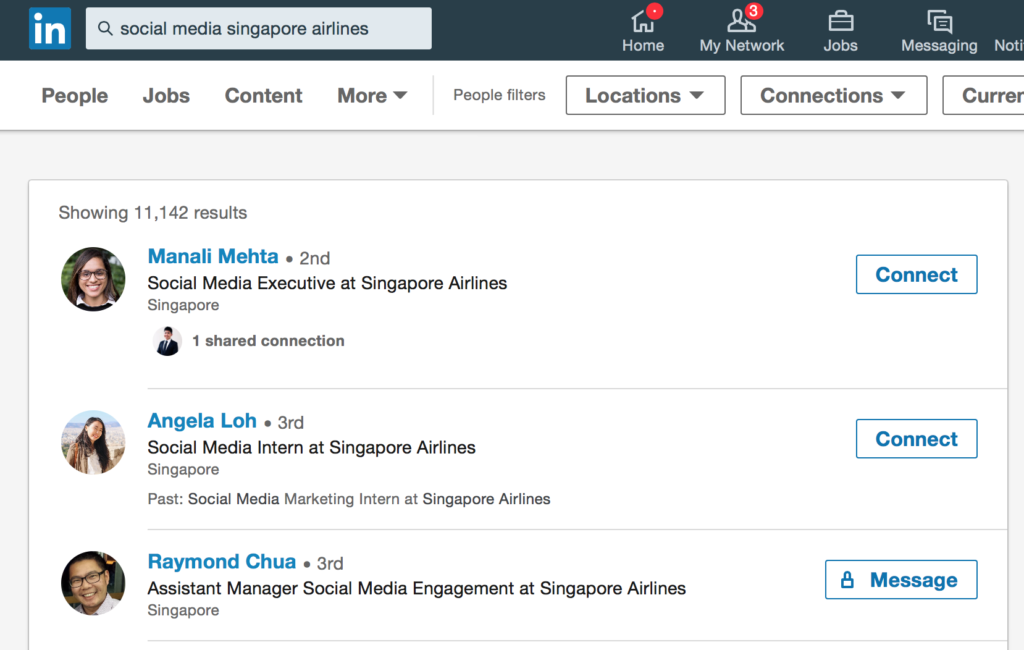
If you can’t figure out who the Hiring Manager is, try approaching a junior or mid level executive in the same team.
Don't target senior directors as they're often too busy to reply unsolicited emails.
In this case, the right person to reach out to would be Raymond Chua, the Assistant Manager.
Step 3: How to Find The Hiring Manager's Email Address
Email not listed on their LinkedIn profile? No problem.
To get the target executive’s email, you can use a Chrome plugin called Skrapp.
Install the Skrapp plugin on Google Chrome.
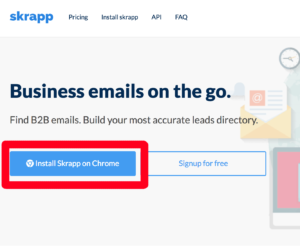
Then, sign up for an account. You’ll then get 100 free email searches a month.
Once that's done, go back to LinkedIn.
Visit the Hiring Manager’s LinkedIn profile. With the plugin installed, you'll be able to see a new button on the profile in Red.
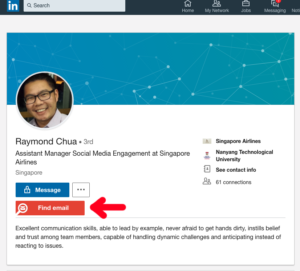
Click that button to get the hiring manager's email address.
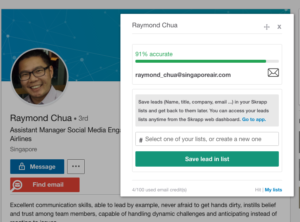
Now that you have the email, let's get down to how to email Hiring Managers:
Technique 1: Send the Hiring Manager Some Smart Suggestions
Show the Hiring Manager that you know your stuff.
Give them some smart suggestions related to the business and your area of expertise.
Here's a simple example:
Email Subject: Improving Instagram Engagement Hello Raymond, I’ve been a fan of XYZ Co.'s Instagram page for a while now. The beautiful pictures always create such a sense of wanderlust in me. Raymond, I’ve noticed that your team uses hash tags to broaden the reach of their posts. Have you tried using Hong Kong specific colloquial hashtags? I’m currently managing the social media account for IKEA in Hong Kong. I’ve found that using Hong Kong specific hash tags get less direct engagement (due to the smaller base) but results in more overall views from users in Hong Kong. This results in us getting a far higher percentage of our viewership from our target market (Hong Kong) which is the KPI we look for. Let me know if you’d like to give that a try at XYZ Co. I’d be happy to toss a few ideas out to you. In parallel, I also heard that XYZ Co. is hiring a social media executive. Is the role still open? I’d love to hear more about it. In the meantime, best of luck Instagram hunting! Best regards, |
If you were the Hiring Manager, how would you feel upon receiving this email? If it were me, I'd be awfully impressed!
So impressed that I would take a phone interview (at minimum) with Rachel.
That's why cold emails like these often result in outstanding response rates. They're too impressive to turn down.
Putting together an email like this takes a lot of effort, but don't fret – you can often re-use them for similar job applications, with a few minor tweaks.
This method takes significantly more effort, but it’s definitely worth it!
Technique 2: Ask the Hiring Manager for a Small Favour
Now, here's a different approach, but one that's equally effective.
When we first thought to do this, our team tried out a more direct cold email strategy.
Together with a client, Sarah, we found the Hiring Manager's email on LinkedIn, crafted a beautifully worded email – complete with deadlines, bold headers, and a clear CTA (call-to-action) requesting a coffee meeting with the Hiring Manager.
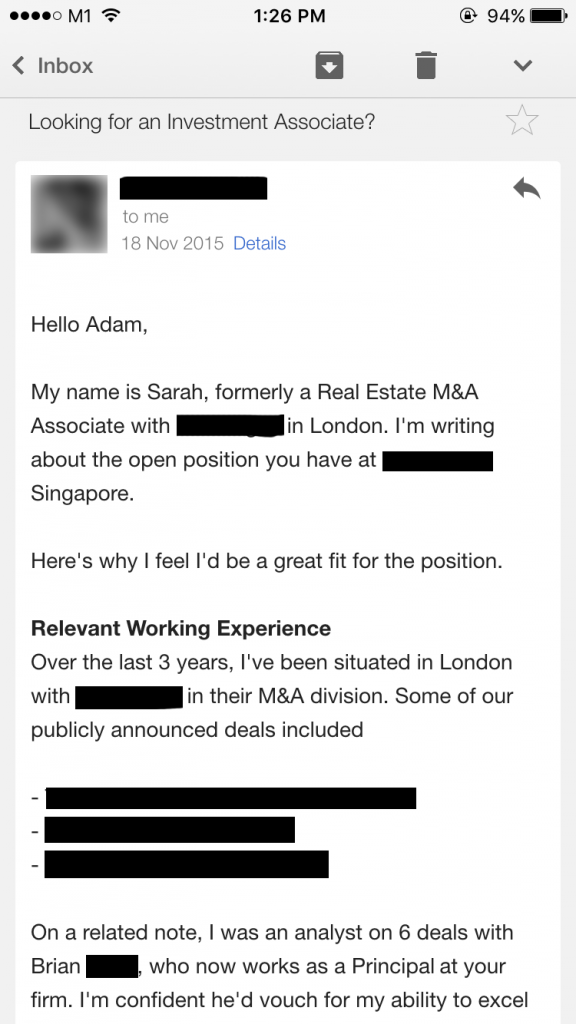
And the result was...
0 RESPONSES from 8 emails to 8 different Hiring Managers.
And mind you, these were positions our client was highly qualified for.
When 1 person doesn’t respond, we can assume they’re busy or are having a bad day. When all 8 don’t respond, we know our strategy was wrong.
So we went back to the drawing board, and a week later, we used a simpler approach with a simple, clear email, and sent it to another 8 executives:
Dear Hiring Manager, My name is Sarah, formerly an Investment Associate at XXXXX in London. I'm interested in the XXXX position open at your firm. Could we have a quick call to discuss 3 questions I have? If you're not available for a phone call, I can send over my questions via email. |
A day later, my jaw dropped when Sarah updated me on the results.

RESPONSE RATE: 87.5%. That’s 7/8 people!
After they responded to our one-liner email, we then sent that same long email detailing Sarah’s accomplishments and background — and all 7 Hiring Managers agreed to grab coffee with our client.
That was a BIG deal.
Grabbing coffee with the hiring manger prior to the interview is the shrewdest career move you can make. Why?
- You’ll develop a relationship with the Hiring Manager. They’ll know you so much better compared to other jobseekers.
- If you ask the right questions, the coffee meeting will almost certainly lead to a call to the final interview round, bypassing the HR department and all those other job seekers who applied through the various job portals.
- When you do eventually walk into the interview room, everyone will know you. They’ll be smiling. The interview will just be a formality.
And it all starts with that one-line email to the Hiring Manager.
The trick to successfully getting responses from executives is this: when asking for a large favour, don't be upfront about it.
For example, if you need feedback on a new report from a colleague, don't send them a 600 word email detailing all the problems you see with the report. Instead, send them a one-liner email first:
| Hey, I need some feedback on my report. Can I send it to you? |
Almost everyone will say yes to a message like that. It seems like an easy ask.
Only when your colleague has committed to helping you, do you send over that mammoth 600 word email. Since they've already promised to help you out, they'll be far more obliged to return that email with some great feedback.
So in summary - ask a small favour first, get the Hiring Manager to commit, then ask the big favour.
Offering career advice to random strangers, like Sarah, is a big ask. Most senior executives are swamped for time.
If a senior executive senses your request is going require a heavy time commitment, it's likely they'll refuse or more commonly, just ignore your email!
Our original email with Sarah was far too long. It was the classic example of asking for too much, too early.
That simpler approach received 7 out of 8 positive responses from Hiring Managers at large investment banks in Singapore.
Some elected for a phone call, others preferred conversing via email. Either way, Sarah got in touch with 7 senior executives all from cold emailing them in Singapore. It's a fantastic achievement when you consider that Sarah isn't even from Singapore and barely knew anyone here who could help her.
Conclusion
These simple email outreach techniques can be done by anyone – so why not give them a go yourself?
They do take some additional effort, but the results could be well worth it :)
Besides these, there are dozens more job hunting strategies, best practices, and hacks every jobseeker should know.
Here are some of them – use them well!
Additional Job Hunting Tips:
- Your Cover Letter is just as important as your CV! Download our Cover Letter template and follow the steps of our Ultimate Cover Letter Guide to stand out from the competition. Get inspired by these winning Cover Letter examples that have actually landed our clients jobs at the likes of Airbnb, Facebook, and more.
- Building up your LinkedIn presence is one of the best things you can do for yourself in today's job search landscape. Having an up-to-date LinkedIn profile, filled with the right keywords, makes you easily discoverable to potential employers. Here's how to write a great LinkedIn profile.
- If you've landed an interview, great! Be sure to prepare well for these common interview questions, and follow our tips and tricks to ace your job interview.
- Benchmark your salary against others in your industry, to negotiate the pay you deserve. Check out our complete Hong Kong salary guide for your industry
If you found this article useful, you might also like:
- Complete List of Headhunters in Hong Kong
- How to Customise Your CV for Different Companies
- Understanding Competitive Advantage
- How to Write an Outstanding Job Application Email
- Most Common Job Interview Questions (and How to Answer Them!)
- How to Ace Your Interview

